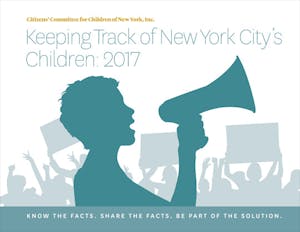

Keeping Track of NYC’s Children in 2017
Insights
November 9, 2017

With New York City’s families just beginning to recover from the Great Recession, now is an important time to focus our attention on the needs of children and families.
Coming off citywide elections, we must acknowledge progress where it’s been made – with efforts underway in New York City to build a more equitable city that provides for improved well-being and upward mobility such as minimum wage increases, expansion of sick leave, pre-k for all four year olds and now 3-K, universal after-school for middle school students, affordable housing development, free lunch for all public school students, the Thrive initiative to address mental health needs, and more.
With the largest population of children in the country, what we do for our youngest New Yorkers has the potential to raise the bar nationwide on how we approach efforts to strengthen outcomes and combat disparities. We must leverage the data to help us identify opportunities to build on recent successes and better address the barriers to well-being children and families continue to face in their daily lives.
The new edition of Keeping Track of New York City’s Children, CCC’s biannual data book on child and family well-being in the city helps paint a picture of how children are faring citywide, in each borough and across the 59 community districts. The data in Keeping Track 2017 tell us that there has been encouraging progress across a wide range of issue areas positively impacting children and families. At the same time, all New Yorkers should be concerned about the wide disparities that persist across race, ethnicity and communities.
Key findings from Keeping Track 2017 include:
- Income: Though median incomes have begun to return to their pre-recession levels, median family income is over $200,000 in some districts, compared to just over $20,000 in others.
- Housing Stability: Despite the economic recovery, nearly 70 percent of poor New York City households spend at least half of their income on rent and the number of families with children entering homeless shelters increased more than 20% from 2013 to 2016.
- Youth: The share of 16 to 24 year olds who are disconnected (not in school and not working) is at a ten year low; however, in several communities more than 20 percent of youth are disconnected.
- Teen Birth Rate: The teen birth rate has been declining steadily citywide, but there are significant geographical and racial/ethnic disparities, with Latina girls having by far the highest teen birth rate.
- Child Health: The infant mortality rate (IMR) has dropped citywide, but is three times higher for black infants compared to white infants.
- Early Education: Over 60 percent of 3 and 4 year olds are enrolled in early education programs, but that number ranges from 72% of white children to just 51% of Latino children. White children are much more likely to be in private programs.
With the data clearly highlighting the need for greater investment and action to help address the needs of children and families and promote economic mobility, CCC is proposing several solutions that should be enacted in the coming months and years:
- The foundation for a child’s social and emotional growth and school readiness is set in infancy and much more must be done to expand access to affordable family-based and center-based care for infants and toddlers.
- As Pre-K for All and 3-K continue to expand, the roll out of new seats must be managed in a way that promotes an integrated system serving all race, ethnicity and income groups. In addition, achieving salary parity for similarly licensed and credentialed teachers and staff is essential not only to supporting quality programs but also to combatting income inequality in the sector.
- As the city moves forward with plans to expand affordable housing, incentives should be leveraged to create parks and playgrounds, and bring food retail and community service spaces to new developments.
- Build on the recent expansion of middle school after-school programs to make elementary after-school universal so that the youngest school-age children benefit from social and academic support and expand summer programming to prevent learning loss when school is out.
- Access to transportation is a critical ingredient in school participation, labor force attachment and economic mobility; and yet, far too many regions of the city are socially isolated and the cost of transportation is prohibitive for poor New Yorkers. Reduced-priced MetroCards should be offered and transportation alternatives in hard to reach communities – vans, shuttles and buses – should be created.
- Increased attention must be paid to the unique needs of homeless children and their parents — prevention must not only be strengthened, but significant investments must be made to provide appropriate services while children are in shelter as well as to continue needed supports once the family is permanently housed.
- New York City’s local Earned Income Tax Credit and Child Care Tax Credit, which benefit hundreds of thousands of households, should be considered for deepening and broadening of access.
- To build on efforts that promote health equity across the city, we must invest in clinical capacity to ensure timely access to health and mental services for high risk populations and promote multi-generational approaches to wellness programming.
This data book is a call to action for New Yorkers to do better by our city’s children by prioritizing policies, budget decisions, legislation, and programs that ensure that no child’s fate is determined by his or her racial or ethnic background or zip code.
Order a copy of Keeping Track 2017, download the PDF of the presentation from the data launch, and visit Keeping Track Online to explore what life looks like for children and families in your neighborhood and surrounding zip codes. To learn more about where families are recovering from the 2008 recession and where disparities have widened, check out our infographic summary of 2016 census data.


